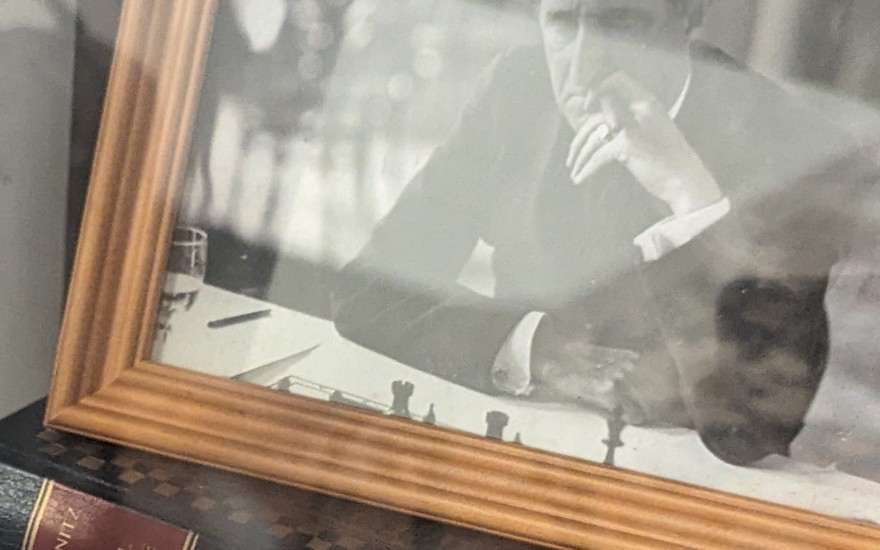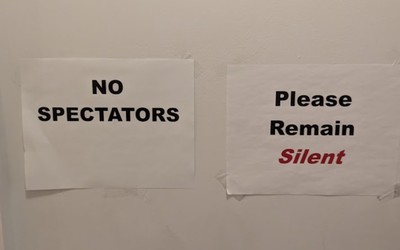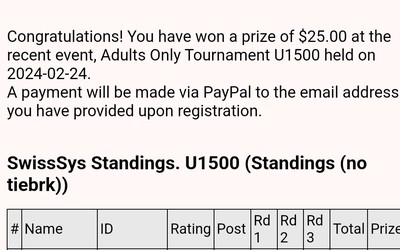
Recap: Marshall Monday U1800 Round 2
d4, g3, Bg2, Nf3...It seems like many lower-rated adult players that I face use the same formula:
- d4, g3, Bg2, Nf3...
- Move a few more pawns out into the center and develop a few more pieces innocuously.
- Lots of pawn tension, difficult to see what the correct move is.
- Pawn break!
- Tactics I didn't see behind all the pawns suddenly spring out. I lose a pawn or even a full piece.
Whenever I see those first 4 moves, I feel... disappointment. My opponent isn't looking for any immediate fight and instead wants to have a temporary truce: "you develop your pieces and I'll develop mine, then the fight will begin." Well, going forward - I'm having none of that.
At any rate, last night's game was a case study in the above. Because I had resolved to play solid mainlines and not go for anything "gimmicky" or early combinations. Instead, I had decided that if my opponent played a "slow" d4 opening, I would respond with the Old Indian Defense - at the recommendation of my coach.
The Game
In this game, the opening was slightly different - but the overall plan was the same. Slow opening, "improve pieces" behind a pawn cover, then pawn break and capitalize on tactics. Meanwhile, I was hoping pieces around looking for things to do. Not very engaging game...
Model Game: Dziuba - Gallardo Fernandez
As is my practice now, after most games I find a model game that used a similar opening. In this case I found a game by GM Marcin Dziuba that followed a similar opening, but where the GM made a few different decisions. Ultimately the pawns disappeared and there were tactics, but the GM had the upper hand in the end.
Learnings
Second thoughts on Old Indian Defense
Old Indian probably isn't the opening for me for these slow d4 / c4 openings. I need to find an aggressive response to 1. d4 and 1. c4. I.e. an early d5 and exchanging pawns - even giving up a pawn to open up lines for development and piece activity.
Why to Play a4 / a5
I finally understand why sometimes a4 / a5 is better than a3 / a6 ... It grabs some squares on the opponent's side, i.e. preventing b4 / b5, while also freeing the a3 / a6 square for a bishop. If you play "dog ears" a3 / a6, then you can't put a bishop on those squares.
Dealing with Offered Pawn Breaks
When an opponent offers a pawn break, look for any obvious tactics, i.e. if you allow them to capture your pawn, will it fork two of your pieces?
If tactics are not clear, then assess if your own pieces are well-developed. I.e. do you have bishops on diagonals, and are your knights in the center? If not, you probably should not accept the pawn break and keep the position closed - either push past or ignore the pawn break and make a move that improves the position of one of your pieces - no matter how small.
Don't Overweight the Bishop Pair
A few times I didn't trade pieces because I wanted to keep my bishop pair. This was a mistake - having the bishop pair is not useful if your position is so cramped that moving them is impossible.
This is covered in Simple Chess by Michael Stean - trading off some pieces is often the right move for black in a cramped position.
Rated Game Goals Report Card
To wrap up, let's review how I did on my goals for rated games:
Play mainlines and principled moves in the opening.
Yes, done.
Don't recapture any piece without taking at least one minute to calculate.
Done as well - and again I was in time trouble as a result.
Recognize key moments in the game.
Failed. I didn't calculate hard enough when it came time to decide if I should open the position with a pawn break. I was too lazy on just capturing the pawn, wanting to see something happen.
Do the work of calculating potential tactics and checkmates.
Failed. I didn't see at a key moment of the game that my opponent did NOT have a checkmate threat, and I had tactics available as a result.
Under no circumstances play Bxf7 as white
Not applicable - did not occur in game.
Immediately deal with batteries.
Did not occur in game.
If needed, win with a single pawn.
Although the game didn't make it this far, I was at least NOT blundering pawns as I had in other recent games. I recognized my opponent's threats to win a pawn and defended.
Next Steps
Openings Matter. I need to find an opening line that I like for dealing with the English and these similar closed / non-committal openings. I.e Catlan / Psuedo-Catlan / English with g3.
I want a more open game where I disrupt my opponent's plans and immediately pose questions. I don't want them to "set up" and instead would like to make them feel pressure early.
Incidentally, this is my approach as a fencer as well. I don't like passively defending; I am what they call a "pressure" fencer - and for the most part it's worked for me. I want to have the same approach in chess.




